NPS Website; Local Website
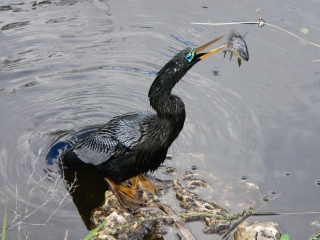 WHAT IS IT?
WHAT IS IT?At 1.5 million acres, Everglades National Park is the largest subtropical wilderness in the United States. This review covers the areas of the park accessible through its main entrance located just outside Florida City, Fla. This stretch of road passes through numerous ecosystems, traveling 38 miles from the Ernest Coe Visitor Center to the Flamingo Visitor Center, located on the Florida Bay.
BEAUTY (9/10)
The section of the Everglades from the Main Entrance to Flamingo is the most beautiful area of the Park because it is the most diverse. A few inches’ change in altitude dramatically alters the landscape. Along the 38-mile drive, you travel through a pineland forest, hardwood hammocks, cypress trees, a freshwater prairie, a mangrove wilderness, a hurricane-created coastal marsh and finally a coastal prairie. Every change is clear and breathtaking. The sunsets are spectacular whether they overlook the pastel horizon of the sandy Florida Bay keys or are through the vertical wonder of Florida pines.
The wildlife is abundant and includes many endangered species. We were lucky enough to see the rare American crocodile but did not see either the manatee or the limpkin. The Everglades are the only place in the world where saltwater crocodiles live side by side with alligators.
The Everglades are an American original. Many of the trails feel more like a zoo than a National Park. The birds, fish and massive reptiles are so close that they seem to mingle with the tourists in such a great number that you are guaranteed to see all but the rarest species.
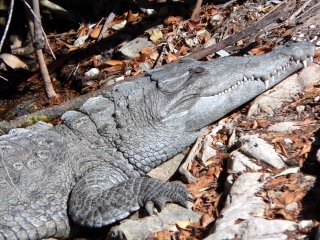 HISTORICAL INTEREST (4/10)
HISTORICAL INTEREST (4/10)South Florida is a very young land mass, appearing anywhere from 6,000 to 8,000 years ago, a veritable newborn. Native Americans are thought to have crossed the Alaskan land bridge over 10,000 years ago, predating the Everglades. Since their creation, the shallow Everglades slowly meandered on its way to the Florida Bay. Human interaction was limited to a few Indian tribes until the turn of the Century when full-scale settlement began in South Florida.
Since then, humans have drained the Everglades, disrupted and redistributed the water flow with canals, dumped sugar cane runoff and untold other waste products into the “River of Grass” and demolished and filled portions for development. The Everglades are in critical condition and there are no plausible solutions, only stopgap measures. Everglades NP is our most endangered National Park.
CROWDS (3/10)
Our crowd interaction at Everglades NP ranged wildly from good to our worst National Park experience yet. First, for chronologies sake, the bad times.
Keep away from the Flamingo campground if you spend the night in the Everglades. We found the campground overrun with rowdy boaters eager to set off the next morning from the nearby marina. Quiet hours were ignored, the vodka poured freely and the overheard conversations were so loud, aggressive and offensive that we feared for our safety.
Lowlights included one group showering expletives upon Park Rangers. The reason: they dared to penalize the man for drunk boating and illegal fishing. Another nearby group collected and chopped down wood (illegal) twice, once at seven and once at midnight while using their idling pickup truck as a spotter. Their massive bonfire party began at 8pm and lasted well past 2 am.
We have run into obnoxious and dangerous boaters at every National Park that allows motorboats. Our experience tells us that our Flamingo incident was all too common especially since we encountered no roaming campground hosts and no patrolling Park security, a first in well over 50 National Park campgrounds. Our sleepless, fear-ridden night nearly ruined our trip to the Everglades.
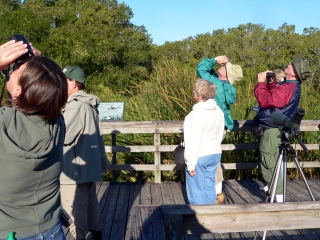 Luckily, our spirits were lifted at 8:00 am around Eco Pond. We happened upon a Ranger-led bird walk and were greeted with an advanced lesson from both Ranger and fellow bird-watchers. Everybody had high-powered individual binoculars and one couple brought a portable spotting telescope that they happily shared. We spotted over 50 species of birds in our meandering two-hour walk. The perfect way to learn about birds is to go with people who know what they are doing. Other than the Ranger, we were the youngest in the group by at least twenty-five years.
Luckily, our spirits were lifted at 8:00 am around Eco Pond. We happened upon a Ranger-led bird walk and were greeted with an advanced lesson from both Ranger and fellow bird-watchers. Everybody had high-powered individual binoculars and one couple brought a portable spotting telescope that they happily shared. We spotted over 50 species of birds in our meandering two-hour walk. The perfect way to learn about birds is to go with people who know what they are doing. Other than the Ranger, we were the youngest in the group by at least twenty-five years.Our walks around the Anhinga Trail, near the main entrance, were wonderful and representative of the classic National Parks visit. The boardwalks were crowded with tourists amazed and enchanted at the exotic floral and fauna they were seeing. So much excitement and so many happy kids.
EASE OF USE/ACCESS (3/5)
The Everglades NP Main Entrance is located 45 miles from Miami and 11 miles from Homestead. The Florida Turnpike, Route 821, ends at Homestead. From there, Florida Route 9336 weaves its way through Florida City and into the Everglades. The road continues 38 miles to the southern tip of mainland Florida, the site of the Flamingo Visitor Center.
There are six fully accessible self-guided interpretive trails along the road through the Park. They take the visitor through six dramatically different ecosystems. The trails allow anyone to amble through the forbidding mangroves, an incredible feat in itself. All the trails are completely flat and make for easy walking. Just don’t forget to bring insect repellent, the mosquitoes are always out in full force.
CONCESSIONS/BOOKSTORE (3/5)
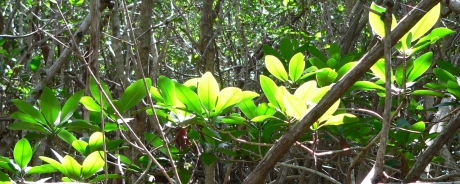 The brightly-lit gift store in the Ernest Coe VC at the Main Entrance followed the same design as bookstores in many of the destination parks – lots of coffee table photography books, key chains, magnets, generic National Park guides and gear. The only exception to the rule was the extensive stock of books for birders.
The brightly-lit gift store in the Ernest Coe VC at the Main Entrance followed the same design as bookstores in many of the destination parks – lots of coffee table photography books, key chains, magnets, generic National Park guides and gear. The only exception to the rule was the extensive stock of books for birders.Flamingo had both an upscale gift store operated by an independent concessionaire and a grocer/convenience store at the marina, but we couldn’t find an actual NPS bookstore in the area. Be sure to get your reading material before you start down the 38-mile road.
COSTS (3/5)
Entrance to the Park is $10 per car. A tent spot at the Flamingo or the Long Pine Key campground is $14.
Like the Gulf Coast portion of the park, much of the Everglades NP serviced by the Flamingo VC is in the water. Canoes, kayaks and fishing skiffs can be rented hourly or by the day. Prices range from $8 an hour for a 2-person canoe to $155 for a 19-foot fishing skiff. Fishing poles and ice chests can also be rented as needed.
The canoe rental fees at Gulf Coast were much more affordable. There were many more motorized boats leaving the Flamingo marina than from their Gulf Coast counterpart. A canoe excursion from the northwest might be more peaceful and definitely cheaper.
RANGER/GUIDE TO TOURIST RATIO (3/5)
The Flamingo Campground, the setting for our horrendous first night, would have been much better with a Ranger patrolling the grounds once or twice. In fact, this is the first NPS campground we have used where we haven’t had an evening visit from an NPS employee, if only to tell us about the evening slide program at the amphitheatre.
The Rangers leading the birders walk and the talk which turned into a walk at the Anhinga Trail were both excellent. Young and enthusiastic, they knew their stuff and both stayed with us long past the anticipated end of the lesson.
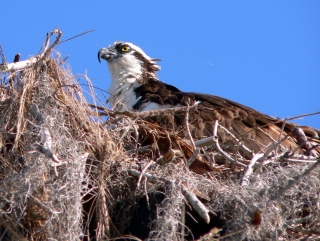 TOURS/CLASSES (8/10)
TOURS/CLASSES (8/10)The NPS runs an interesting array of activities from both the Flamingo (the south) and Royal Palm (near the main entrance in the northeast) areas. The Rangers are the centerpiece of the Park’s highly enjoyable educational experience.
Both areas offer $15, three-hour long, walks through the swamp. Four Ranger-led slogs through the wet leave the south every week while Royal Palm offers the difficult hike every day. Space fills up well in advance.
The Bird Walk around Eco Pond happens from Thursday through Sunday only in the South. The wonderful Ranger who led on the birding excursion also handles many of the swamp walks. She knew every bird, butterfly, tree, spider and flower. Flamingo also offers a daily Ranger-led $20 four and a half hour morning canoe trip. These tours also fill up well in advance.
Royal Palm offers a daily $15 Ranger-led bike hike through the landscape of the north. Simple auditorium-based Ranger talks also take place daily in both areas.
The Park’s Visitor Center Museum is large, confusing and not nearly as helpful as the Rangers. The recent remodeling includes a new and outsourced film. A Discovery Channel logo proves very distracting while it constantly rotates in the lower right corner. The film relies on sped-up camera tricks and nice pictures and fails to scratch the surface of the Everglades’ complex ecosystems and the man-made problems that threaten them.
If the Ranger programs are not enough, two hour long private boat tours leave 8 times a day into both the mangroves and Florida Bay from the Flamingo Marina. Adult costs range from $12 to $18. They are narrated by a professional guide. There is a lot to do in the Everglades.
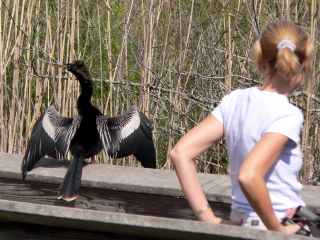 FUN (8/10)
FUN (8/10)The Anhinga Trail near the Park Entrance deservedly enjoys its world-class reputation for wildlife spotting. It is as much fun as you can have on a National Parks boardwalk. And believe what the Rangers say, come back and walk the trail at night. The sounds are amplified, the walk is safe and the atmosphere is enjoyably spooky. The twin beady eyes of the alligator will appear fluorescent red if you shine a flashlight from your eye level into the water. Their silent motion is interrupted only when they creep up on other gators and thrash their tails through the water in territorial battles.
The moon and the stars were so bright that we did not need a flashlight; although a squawking Great Blue Heron did shock us when we unknowingly crept only a few inches in front of his perch. Our terrific time at Everglades NP was dampened only by our night spent in the Flamingo campground with very little sleep.
WOULD WE RECOMMEND? (8/10)
Our two-day visit took us from one extreme to the other – in emotions as well as natural settings. We happened upon two stellar Ranger-led events at either end of the Park without even trying.
If Shark Valley VC offers the visitor an Everglades 101 course, traveling from the Main Entrance to Flamingo is the next level. If you go to Shark Valley, you pay your money, get on the tram, and are sure to see just about everything that ecosystem, a freshwater slough, has to offer.
The road on the east side of the park is long and winds through more landscapes than one should expect to see in a day, let alone along a single 38-mile stretch. Your visit here will be more self-directed; there are no guarantees and the Main Entrance is not as accessible as its name might imply. Your trip here will be more difficult than Shark Valley but could prove to be more rewarding.
TOTAL 52/80
www.usa-c2c.com
© 2004-06